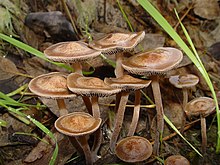
Back Panaeolus cinctulus CEB Brithdegyll cylchog Welsh Panaeolus cinctulus Basque Reunuskirjoheltta Finnish Panaeolus cinctulus French Panaeolus cinctulus ID センボンサイギョウガサ Japanese Gezoneerde vlekplaat Dutch Kołpaczek pośredni Polish Kantbroking Swedish
| Panaeolus cinctulus | |
|---|---|

| |
| Scientific classification | |
| Domain: | Eukaryota |
| Kingdom: | Fungi |
| Division: | Basidiomycota |
| Class: | Agaricomycetes |
| Order: | Agaricales |
| Family: | Bolbitiaceae |
| Genus: | Panaeolus |
| Species: | P. cinctulus
|
| Binomial name | |
| Panaeolus cinctulus | |

| |
| Approximate Panaeolus cinctulus range | |
| Synonyms[1][2] | |
|
Agaricus cinctulus Bolton (1791) | |
| Panaeolus cinctulus | |
|---|---|
| Gills on hymenium | |
| Cap is campanulate or convex | |
| Hymenium is adnate or adnexed | |
| Stipe is bare | |
| Spore print is black | |
| Ecology is saprotrophic | |
| Edibility is psychoactive | |
Panaeolus cinctulus, syn. Panaeolus subbalteatus, commonly known as the banded mottlegill, weed Panaeolus, belted panaeolus,[3] or subbs is a very common, widely distributed psilocybin mushroom. According to American naturalist and mycologist David Arora, Panaeolus cinctulus is the most common psilocybin mushroom in California.
During the early 1900s, these species were referred to as the "weed Panaeolus" because they were commonly found in beds of the commercially grown, grocery-store mushroom Agaricus bisporus. Mushroom farmers had to weed it out from the edible mushrooms because of its hallucinogenic properties.[4]
- ^ Cite error: The named reference
urlMycoBank:Panaeolus cinctuluswas invoked but never defined (see the help page). - ^ Cite error: The named reference
Gerhardtwas invoked but never defined (see the help page). - ^ Arora, David (1986). Mushrooms demystified: a comprehensive guide to the fleshy fungi (Second ed.). Berkeley: Ten Speed Press. ISBN 978-0-89815-169-5.
- ^ Singer and Smith (1958).